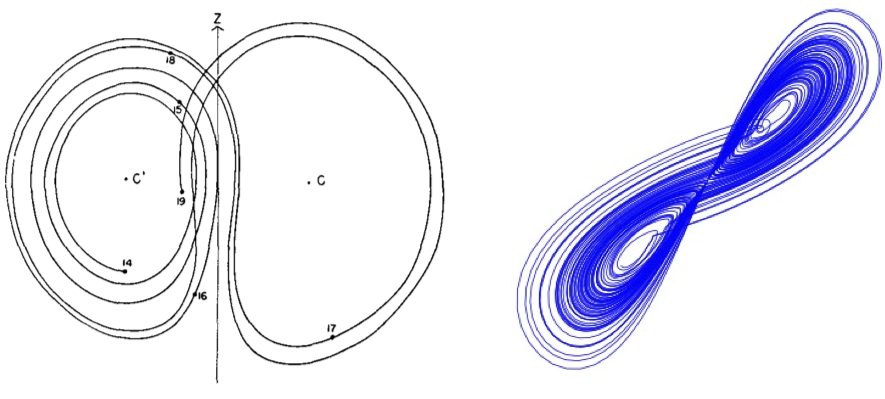This month marks the 50th anniversary of the 1963 publication of Ed Lorenz’s groundbreaking paper, “Deterministic Nonperiodic Flow,” in the Journal of Atmospheric Science. This seminal work, now cited more than 11,000 times, inspired a generation of mathematicians and physicists to bravely relax their linear assumptions about reality, and embrace the nonlinearity governing our complex world. Quoting from the abstract of his paper: “A simple system representing cellular convection is solved numerically. All of the solutions are found to be unstable, and almost all of them are nonperiodic.”
While many scientists had observed and characterized nonlinear behavior before, Lorenz was the first to simulate this remarkable phenomenon in a simple set of differential equations using a computer. He went on to demonstrate the limit of predictability of the atmosphere to be roughly two weeks, the time it takes for two virtually indistinguishable weather patterns to become completely different. No matter how accurate our satellite measurements get, no matter how fast our computers become, we will never be able to predict the likelihood of a rainy day beyond 14 days. This phenomenon became known as the butterfly effect, popularized in James Gleick’s book “Chaos.”
Inspired by the work of Lorenz and colleagues, in my lab at the University of Vermont we’re using Computational Fluid Dynamics (CFD) simulations to understand the flow behaviors observed in a physical experiment. It’s a testbed for developing mathematical techniques to improve the predictions made by weather and climate models.

A sketch of the Lorenz attractor from the original paper (left), a simulation of the convection loop analogous to Lorenz’s system [Harris et al. Tellus 2012].
Here you’ll find a brief video describing the experiment analogous to the model developed by Lorenz:
And below you’ll find a CFD simulation of the dynamics observed in the experiment.
What is most remarkable about Lorenz’s 1963 model is its relevance to the state of the art in weather prediction today, despite the enormous advances that have been made in theoretical, observational, and computational studies of the Earth’s atmosphere. Every PhD student working in the field of weather prediction cuts their teeth testing data assimilation schemes on simple models proposed by Lorenz, his influence is incalculable.
In 2005, while I was a PhD student in Applied Mathematics at the University of Maryland, the legendary Lorenz visited my advisor Eugenia Kalnay in her office in the Department of Atmospheric & Oceanic Science. At some point during his stay, he penned the following on a piece of paper: “Chaos: When the present determines the future, but the approximate present does not approximately determine the future.”
Even near the end of his career, Lorenz was still searching for the essence of nonlinearity, seeking to describe this incredibly complicated phenomenon in the simplest of terms.
Christopher M. Danforth, Ph.D.
Associate Professor
Computational Story Lab
Department of Mathematics & Statistics
University of Vermont
Pingback: Prêt-à-Porter | THE 72 PROJECT